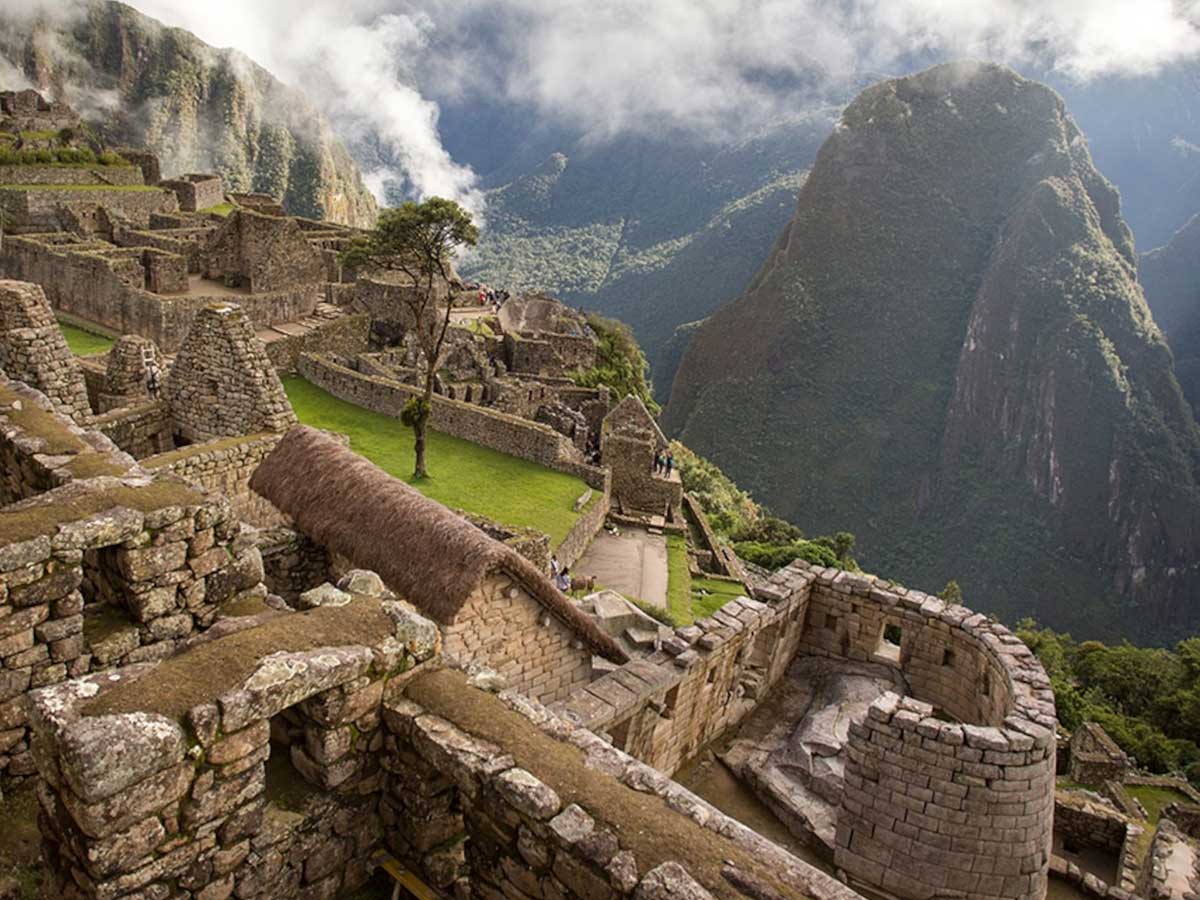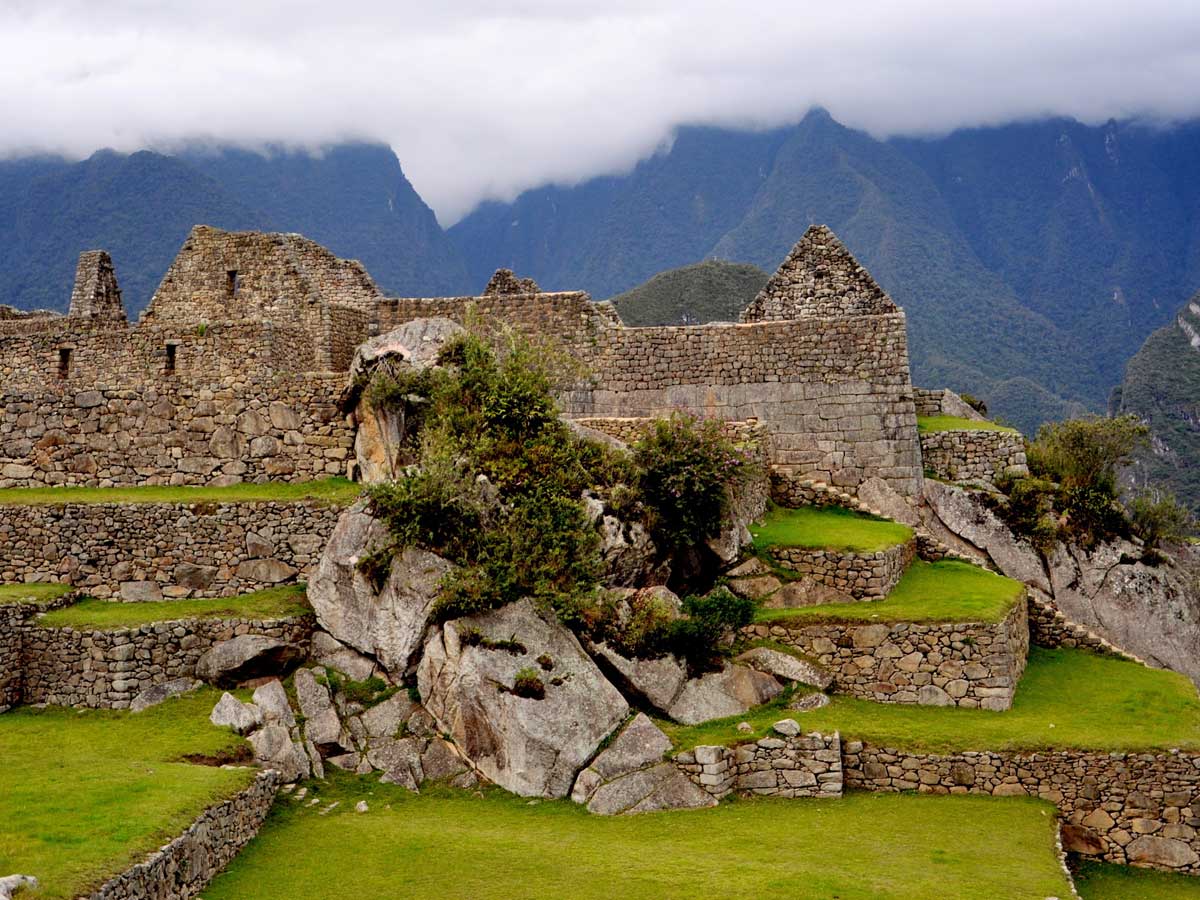
Machu Picchu is an Inca city surrounded by temples, platforms and water channels, built on top of a mountain. Its construction was built with large blocks of stone joined together, without the use of amalgam. At the moment it is considered cultural patrimony of the humanity when being recognized like important political center, religious and administrative of the Incaic time.
This beautiful citadel is located in the district of the same name Machu Picchu in the department of Cusco in the country of Peru located in the province of Urubamba.
The Inca ruins of Machu Picchu are located halfway between the peaks of both mountains, 450 meters above the level of the valley and 2,438 meters above sea level.
Machu Picchu also is the ending point of an amazing journey, considered one of the 5 best walks in the world: the Machu Picchu Inca Trail. This hiking trail is the most amazing way to have the first sight of the Wonder of the World, as the Incas did almost 600 years ago.
Now, we share you some Machu Picchu facts to encourage you to visit ancient Inca citadel so admired by many.
Machu Picchu, the world-renowned archaeological site, owes its fame to Hiram Bingham, an American explorer whose 1911 expedition serendipitously led to its scientific exploration and subsequent global recognition. Interestingly, Bingham's original quest was not to unearth Machu Picchu but to locate Vilcabamba, the last Inca village that had served as a sanctuary from the Spanish conquest in 1572. While traversing the Urubamba Valley, Bingham inquired with local inhabitants about any nearby ancient ruins. It was a native indigenous farmer, Melchor Arteaga, who, conversing in his native tongue, pointed him in the direction of Machu Picchu. The name "Machu Picchu" itself seems to hold its roots in the ancient language, signifying "old mountain" or "old peak," referring to the prominent mountain situated just in front of the citadel.
The mountain immediately behind the citadel, prominently featured in countless iconic postcard photographs, is known as Huayna Picchu, denoting "young mountain." It offers a rewarding ascent of approximately 45 minutes, affording breathtaking vistas and featuring an Inca temple along the way.

When the Spanish first arrived in Peru during the 15th century, they left a trail of destruction in their conquest, often obliterating Inca structures and sacred sites, sometimes replacing them with Catholic churches. Remarkably, one of the key reasons we can now visit and marvel at the remarkably well-preserved archaeological wonder of Machu Picchu is that it remained hidden from the Spanish. This secrecy can be attributed in part to its remote location, but there is also evidence suggesting that as the Incas abandoned the city, they intentionally burned certain structures and pathways to conceal it from prying eyes.
During Hiram Bingham's explorations in the early 1900s, he found Machu Picchu shrouded in dense forest vegetation, which had to be painstakingly cleared. Regrettably, this process resulted in the collapse of some structures. It was during this effort that it was revealed that the over 600 terraces beneath the citadel were ingeniously engineered to prevent it from sliding down the mountain—an extraordinary feat of advanced structural engineering for its era.
As a result, only about 40% of Machu Picchu is currently visible to the naked eye, while the remainder lies concealed beneath protective vegetation to ensure its preservation. Since the initial excavations, there have been limited restorations and reconstruction efforts, but the site remains approximately 75% original, making it one of the most remarkably well-preserved archaeological sites of its time.
During the ‘70s and ‘80s, there were two notable instances when the Peruvian government authorized the temporary removal of a substantial monolithic stone at Machu Picchu to facilitate helicopter landings. These special landings were arranged for the visit of the Spanish king and queen on one occasion and for a meeting of Latin American leaders on another. Regrettably, these helicopter operations resulted in irreparable damage to the stone, ultimately leading to its permanent removal. This unfortunate incident is one of the underlying reasons for the establishment of a no-fly zone above Machu Picchu.
To ensure the sustainable management of this iconic site, strict regulations have been implemented. These include daily ticket limits, capped at 2,500 tickets per day, designated timeslots for entry, and the implementation of a one-way walking system to manage and minimize foot traffic. For comprehensive information on the specific guidelines and rules governing visits to Machu Picchu, you can refer to our Machu Picchu Regulations page.

Speaking of the lush surroundings, Machu Picchu is ensconced within the cloud forest, often referred to as the high jungle. Visitors are often taken aback by the unexpected beauty of the vibrant, verdant flora that rivals the grandeur of the citadel itself. This cloud forest teems with a rich diversity of plants, insects, and other wildlife, showcasing a striking array of over 300 orchid species.
If you opt to embark on the time-honored pilgrimage to Machu Picchu along the Inca Trail, you will be treated to an even more profound encounter with the region's extraordinary biodiversity. Your journey will lead you through mountain passes, valleys, and a series of distinctive microclimates, offering a firsthand exploration of this natural wonderland. Alternatively, for those who prefer a more accessible route, visitors to the site can effortlessly board a train to Machu Picchu town (Aguas Calientes) and then hop on a bus directly to the citadel, making Machu Picchu a welcoming destination for travelers of all ages and abilities.
If you're fortunate, you might catch a glimpse of the elusive spectacled bear (also known as the Andean bear or Tremarctos ornatus) while exploring Machu Picchu or traversing the Inca Trail. This distinctive bear species is exclusive to South America and is currently categorized as vulnerable by the IUCN, with an estimated population ranging from just 2,500 to 10,000. While their sightings are exceedingly rare, some lucky visitors have spotted them in the vicinity of the citadel, typically around 4 pm or later when the crowds thin out. These bears make fleeting appearances before retreating deeper into the cloud forest. They have a particular fondness for bromeliads, which are abundant in this region.
On a more predictable note, llamas are a common sight at Machu Picchu. Although these are domesticated animals that you wouldn't normally encounter in the wild, they have adapted well to the site, providing entertainment for tourists. You can even take selfies with these friendly creatures, but do keep in mind that their least pleasant response to annoyance is spitting. Llamas held great significance for the Incas and would have been present as domesticated animals during their era. Some constructions are even said to resemble the shape of a llama, and llama bones have been discovered at sacrificial temples within the site.
The structures of Machu Picchu showcase remarkable stone craftsmanship, with stones that fit seamlessly together, and this precision has endured for over 500 years, achieved without the use of forges, mortar, or adhesive.
Surprisingly, over 50% of Machu Picchu lies beneath the surface, serving as foundations for certain edifices and as intricate water channels and drainage systems designed for rainwater, irrigation, and consumption.
Machu Picchu is typically divided into two distinct zones: the agricultural and urban sectors. It's estimated that slightly more than 1,000 individuals resided within this concealed mountain city.
Machu Picchu was left incomplete and deserted, a factor that safeguarded it from the alterations and destruction imposed by the Spaniards on other Inca cities.
The availability of abundant water sources and a multitude of terraces enabled Machu Picchu to potentially sustain a population of more than 4,000 people, a fourfold increase from its historical inhabitants.
The trek to Machu Picchu is renowned as one of the world's premier treks and undoubtedly one of the most breathtaking ways to approach this iconic site.
A prohibition exists against the airspace over Machu Picchu National Park, yet in 2016, Peruvian President Ollanta Humala defied this restriction by flying over the Inca City in a helicopter.
In the Main Square of Machu Picchu once stood a monolith, but it was relocated twice to create a heliport. The first time was for the Spanish monarchs, and the second for a gathering of Andean Community of Nations leaders.
Regrettably, during the second relocation, the monolith was damaged and subsequently buried near the Main Square.
Machu Picchu has earned a place on the list of 100 historical monuments worldwide at risk.
As the paramount tourist attraction in Peru, Machu Picchu faces ongoing threats from commercial interests advocating for the construction of luxury hotels and tourist-oriented restaurants in close proximity to this iconic wonder.
2 Day Train Tour to Machu Picchu
